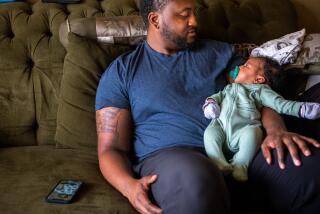Baby blues not just a mom and her hormones thing
In women, postpartum depression is well-known, long-studied and blamed in large part on biological factors. After all, pregnancy-related hormone levels plummet after the baby’s birth, leaving many new moms weepy on the very day they arrive home from the hospital. From there on out, recovery from labor, bodily changes and nursing (or not) can contribute to, if not trigger, both the milder baby blues and outright clinical depression.
But new fathers suffer from pre- and postpartum depression as well, researchers have learned.
In a paper published in May in the Journal of the American Medical Assn., as many as 1 in 10 men met the criteria for serious depression shortly before or after their partner’s baby was born. The numbers were based on an analysis of 43 studies encompassing 28,004 participants.
“Any new mother or father is typically stressed — even if everything is going OK — by having the baby,” says Dr. Laura Miller, who directs the Women’s Mental Health Division at Brigham and Women’s Hospital in Boston. “It results in sleep deprivation, new role adjustments within the family, changes in the workplace [and] financial stressors.”
The new findings emphasize that pre- and postpartum depression can’t be written off as a biological, and thus unavoidable, fact of life. Here’s a closer look at what’s known about the non-hormonal factors in such depression, and how women and men can help prevent, or combat, the condition.
•
Estimated rates of postpartum depression in women range from about 13% to 19%. Strictly defined, postpartum depression is diagnosed by the criteria for major depression — overwhelming feelings of sadness, guilt or worthlessness for at least two weeks — beginning sometime in the month after the baby is born.
Some practitioners think that window should be extended to one year after a baby’s birth.
“There’s actually a continuum of illness,” says Deepika Goyal, a nurse practitioner on the faculty of San Jose State University. That continuum begins with the so-called baby blues, which start right after the birth, typically fade in about a week and are not considered an illness. “That is hormonal — when you come home and your husband asks you how you’re doing and you just start crying,” she says.
Continued blue feelings might signal a depressive state. But Goyal points out that nothing is normal in that first month. “Nobody in that house is getting sleep, everyone’s routine is up and down — like everyone’s in a washing machine,” she says.
A vulnerable time
After three months, however, things do start getting back to normal. Tthe mother may return to work, and relatives who may have come to help go home. “Reality sets in,” Goyal says. “That’s where you say, ‘Oh, now I’m on my own.” She views this as a vulnerable time for depression to set in, for both mothers and fathers.
The risk factors for postpartum depression include personal or family history with depression. “Those are the big two,” Miller says. “The other big one is a lack of social support, especially in the context of high stress.”
A classic 1996 study, published in the International Review of Psychiatry, found that low social support is a strong predictor of postpartum depression in women.
Miller says it’s not simply the amount of social support — whether from partners, extended family or friends — that puts a mother at risk but how she perceives that support and how available that support is. Just knowing she could call someone in the middle of the night, even if she never does it, can be protective.
A 2001 review of 84 studies, published in Nursing Research, identified 13 predictors of postpartum depression in women. Although a few of these might have hormonal elements, such as prenatal anxiety and maternity blues, the vast majority could be relevant to men.
In addition to a history of depression, social support and life stress, other predictive factors were marital relationship, childcare stress and infant temperament.
“We’ve got to stop thinking in this simplistic way and recognize that everyone is vulnerable to change. One hundred percent of people who go forth and multiply are impacted,” says Jane Honikman, an advocate for postpartum depression awareness who, in 1977, founded Postpartum Education for Parents in Santa Barbara, a community support group for new parents that’s still active.
Need for screening
How to identify and treat men who are suffering is not at all clear, but then there’s no consensus on how to screen and treat women either. Nor is there consensus on who should do such screening — obstetricians, pediatricians or general practitioners.
The problem is not whether screening works, because it does, Miller says. “But screening all by itself, without having a plan of what to do after, doesn’t lead to improvement in that depression.”
In other words, without a clear action plan on the part of both patient and doctor, such as knowing mental health practictioners who are taking referrals and making sure there’s insurance coverage, screening won’t work.
For fathers, this may be all the more difficult, as they are less likely to attend prenatal visits or even well-baby visits, Miller says. “That being said, there are more opportunities to help than we are taking advantage of.”






